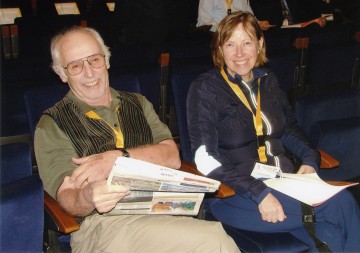The husband and wife team of Shelly Naiman and Linda Vickars devoted their careers to solving the puzzles of hematology, including bleeding and clotting disorders. So when the time came for the couple to plan their giving, they decided to enable such sleuthing by others.
Drs. Naiman and Vickars created an endowment with a $30,000 gift and made a planned gift to the Centre for Blood Research. The funds will support the education and research of trainees, a clinician-scientist to conduct research and a visiting professor – all in the areas of non-malignant (i.e., non-cancerous) hematology, a category that includes inherited and acquired bleeding and thrombotic disorders, red blood cell and platelet disorders, and white blood cell abnormalities.
“Our careers were part of our lives in an enormous way,” Dr. Naiman says. “We would like to see the learning continue, particularly in the field we truly love.”

Shelly Naiman & Linda Vickars
Dr. Naiman, the founding head of the Division of Clinical Hematology at Vancouver General Hospital, was instrumental in establishing the Bone Marrow Transplant Program for British Columbia and later became head of the hematology laboratory at St. Paul’s Hospital. A former Clinical Professor, his other passion was teaching, exemplified by the fact that he won numerous teaching awards and was the first recipient of what is now known as the Dr. Patricia Clugston Memorial Award for Excellence in Teaching from the Professional Association of Residents of British Columbia.
Dr. Vickars, a Clinical Professor in the Division of Hematology who headed that division for 12 years at St. Paul’s, oversaw the establishment of the Provincial Hemogloginopathy Program for adults. (Hemoglobinopathies, such as thalassemia and sickle cell disease, are genetic disorders of red blood cells most commonly seen in persons of particular ethnic groups.) She also oversaw the use of medication to reduce potentially life-threatening iron levels in persons requiring chronic transfusion therapy.
“Mine was a career of teaching and laboratory work,” Dr. Naiman says. “Making a diagnosis of a bleeding disorder was always a challenge – I loved that sort of thing. My wife did too, and she did it well, at the bedside.”
During their combined 65 years of diagnosing and treating non-malignant blood disorders, the couple have seen major changes in these areas. In the 1960s, people with severe inherited bleeding disorders usually did not survive past their teenage years; now they may live into their 80s or beyond. That success brings new challenges – for example, treating heart attacks or strokes with blood thinners, which carries obvious risks for people who are prone to excessive bleeding. They hope the endowment they created will continue to stimulate interest in the field among medical residents, physicians, postdoctoral fellows, graduate students and science undergraduate students.
“The estate gift will open up all kinds of opportunities for education and training of future generations,” says Professor Ed Conway, Director of the Centre for Blood Research. “And the thinking behind the gift is fitting. Clinical practice has changed dramatically, but it would never have happened without the knowledge-base built through research.”
“More and more, especially lately, we’re getting answers and solving puzzles because of the research that’s being done,” Dr. Vickars says. “I’ve looked after families and known something wasn’t quite right, yet didn’t have the tools at the time to work it out. Then I’d get a phone call from a research laboratory with the answer. It was very exciting, not only for me, but especially the patient and their families!”

The Naiman-Vickars Multipurpose Lab, Life Sciences Centre
The Multipurpose Laboratory at the Life Sciences Centre at UBC is used by all incoming medical students as their initial hub of learning. It is fitting that this laboratory is now named in honour of Drs. Naiman and Vickars.
This article first appeared on the UBC FoM Website and is published in The Magazine of the UBC Faculty of Medicine Vol 8, No 1, Spring 2012. For donations, please click here.



Comments are closed, but trackbacks and pingbacks are open.